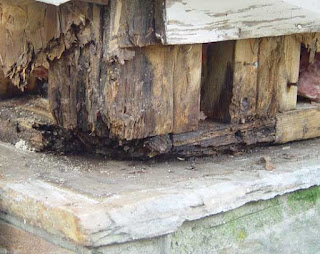EVERYTHING YOU NEED TO KNOW ABOUT WOOD ROT REPAIR
Wood is used in almost every home in the United States, and it’s not difficult to understand why—it’s beautiful, strong, durable, easy to work with, and renewable. With proper care and maintenance, timber homes can stand the test of time and last for centuries.
But there is one thing that puts a damper on the wooden features of your home—the dreaded wood rot. It doesn’t just look disgusting, it’s also a serious threat to the structure and safety of your home.
If you’re reading this, you probably suspect that your home is in need of wood rot repair. But what are the signs? What causes it? And how can you get rid of it for good? Read on to find the answers to your questions about repairing rotten timber.
What is Wood Rot?
It is decay caused by fungal growth in damp wood. When timber becomes damp enough to have 20% or more moisture content, and isn’t able to dry out quickly or is repeatedly dampened, it creates the ideal conditions for wood-eating fungi.
There are numerous species of fungi that can cause rotten timber, but there are three types of wood rot that commonly affect homes, categorized by the way they break down the fibers: white rot, brown rot, and soft rot.
WHITE ROT
The fungi that cause the white variant attack something called lignin, which is part of the structural material of timber. Because it breaks down the lignin, leaving the light-colored cellulose intact, it gives rotting timber a white or yellowish appearance. It also gives a spongy or stringy texture.
White rot-causing fungi prefer temperatures between 65 and 90 degrees Fahrenheit, making the interior of most houses an attractive place for it to grow. And, while we definitely don’t recommend finding a fungus growing in your home and popping it into your mouth, it’s interesting to note that white fungi are also commonly found on dinner plates—for example, shiitake mushrooms.
BROWN ROT
The brown variant is often called dry rot because it makes the surface of the rotted timber appear dry, but don’t be fooled—it still needs a moisture content of 20% or greater in order to start growing. It breaks down the cellulose in wood, causing the wood to shrink, turn a dark brown color, and break apart into roughly cube-shaped bits. This process is called cubical fracture.
Like the white variety, brown fungi prefer to grow in temperatures between 65 and 90 degrees Fahrenheit. However, unlike the white, brown fungi are capable of traveling through or over materials such as plaster and brickwork. It only attacks lumber, but if it’s left behind on other materials it can simply travel to and re-infect timber that has already been repaired. This makes the brown variant particularly difficult to eliminate.
SOFT ROT
The third type of fungi is soft, which secretes an enzyme that breaks down the cellulose, creating tiny cavities. It can cause discoloration and cracking that appears similar to the effects of the brown variant. Again, the lumber must have a fairly high moisture content for soft rot fungi to grow.
There’s good news and bad news about the soft variant. The good news is that it is much more commonly found in fallen trees than houses. Soft fungi grows slowly and is less aggressive than white or brown fungi. The bad news is that the soft fungi is capable of thriving in a much wider range of temperatures, between 0 and 110 degrees Fahrenheit. This means that it can appear on your home and is more likely to be able to grow on an exterior that is subjected to more extreme temperatures.
Where is Wood Rot Found in a Home?
As mentioned above, rot-causing fungi require a moisture content of 20% or more in the wood in order to begin growing. That’s why it commonly appears in kitchens or bathrooms, where water might spill or leak directly onto timber, or it may be frequently exposed to damp, humid air from showers.
But, it’s important to remember that it often doesn’t “appear” at all, because it’s hidden from sight inside your walls and floors. Also, note that fungus doesn’t limit itself to just infesting bathrooms and kitchens. It can develop on any lumber that meets its conditions for growing.
Some common locations where it can be found include:
Under sinks
Windowsills and window frames
Door frames
Basements
Attics
Decks
Fences
Siding or paneling
Thresholds
Steps or stoops
Eaves
How Do I Check For Wood Rot?
Because it’s often tucked away out of sight, it can be challenging to detect. However, the serious consequences of leaving rotted material unchecked make it worth your time to inspect your home annually for any signs of rotting wood.
If you’re concerned that you’re not up to the task of finding it, rely on Fixrot.co.uk to perform your annual maintenance check. We are experienced with treating rot, so we’ll be able to efficiently investigate and eliminate anything that may be threatening your home.
LET’S GET STARTED
To examine your home thoroughly, grab a flashlight and screwdriver and start making your rounds. The above list of common locations is a good place to begin, but you may have vulnerable wood in other parts of your home as well. Think about all the places throughout your home where you can see or touch timber, even in hard-to-reach areas like the attic or crawlspace.
LOOK FOR VISIBLE CLUES
Using your flashlight if necessary, take a good look at the visible wood in your home. The main things you’re looking for are:
Patches of discoloration that are either lighter or darker than the surrounding area
Places where chunks are falling away from the main structure
Texture changes where timber appears sponge-like or stringy, or has a web of cracks and loose pieces on the surface
Timber that is breaking up into cube-shaped chunks
If it’s quite advanced, you may see fungal growth that looks like mushrooms sprouting
Can I Repair Rotted Timber?
The answer is yes, maybe. There’s generally something that can be done to rid your home of rotten timber, but whether it can be repaired or needs to be replaced entirely depends on the level of decomposition.
If the timber is soft to the touch, crumbling apart, or has fungi sprouting out of it, it’s beyond saving. All the rotten parts will need to be removed and replaced. It might not be necessary (or even possible) to remove the entire piece, though. If only part of the piece is affected, it may be possible to remove just the rotted parts and fill the holes with epoxy or polyester filler.
If the timber is in the beginning stages of rot—you might see some discoloration, but it’s not soft or crumbly—it may be possible to apply a fairly simple treatment to stop it from spreading.
But, before you run out to the hardware store, be aware that there’s some potential pitfalls to amateur repair. When you’re not experienced in finding and eliminating rot-causing fungus, it’s easy to miss patches or fail to treat them properly, meaning that all your hard work will be in vain and your home will continue to be damaged.
It can actually end up costing you more than a professional Fixrot.co.uk, if you’re not being thorough enough or you accidentally damage your home attempting your own repairs. You’ll also need to purchase tools and repair materials if you don’t already have them.




Comments
Post a Comment